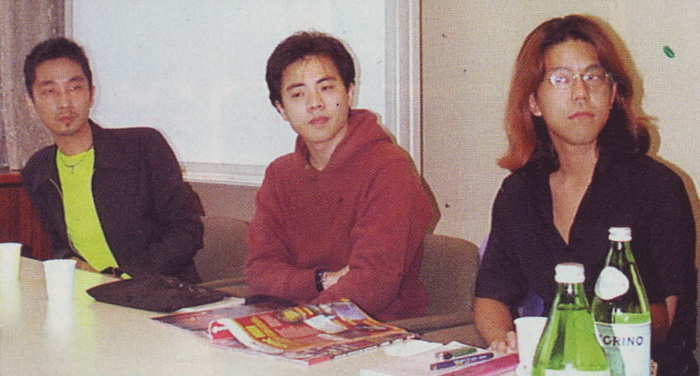Interview with Keiichiro Toyama & Takayoshi Sato (OPM)Date published: 1999.03

At the most recent Tokyo Game Show, we got a chance to speak directly with the core team behind this amazingly atmospheric title. Present at the press conference were Keiichiro Toyama (above center), producer and director; Akira Yamaoka (above left), composer and sound director; and Takayoshi Sato (above right), character designer and computer graphic artist. Where did the inspiration come from for the story? Keiichiro Toyama: The original concept actually came from the corporate side; they said we should try our hand at making a horror game. At the time I was asked to work on this project, I didn't know too much about horror games or horror in general, so I started doing my homework. I looked at what sort of horror people were looking at and enjoying and found that the modern horror theme was the one that was getting the most acceptance. What I found was that a lot of modern horror was based around a real-world situation or setting. I wanted to build on these concepts, starting with any Midwestern American town and building the horror image upon it. Is it true that the team went to Chicago for research? KT: On the way back from E3, we set aside a little extra time to go to Chicago to check out some things and take some pictures. Silent Hill is supposed to be a water resort, so we looked at areas close to the lake for inspiration. Next time we'll set the game in Jamaica (laughter). What was your goal in creating the atmosphere of the game? KT: There were two main concepts we wanted to put into this game. One is that we wanted to make the player feel that the world exists. We took influences from Stephen King for the modern horror atmosphere, so you have all these indications that this is taking place in our modern world. We wanted to have the horror feeling, but we also wanted to make it feel real to the player. The second concept we wanted to focus on was the technology, to create this world in full polygons with a free-floating camera that changes a lot to'keep the player really unbalanced, and to use a lot of fog effects and lighting effects. Did you have any particular influence with regard to those cinematic camera angles? KT: In order to give the game a feeling of a real world, but an unbalanced world, we took influences from David Lynch, Cronenberg, that cinematic style. What do you think of other horror games, like Resident Evil? KT: Resident Evil 2, in particular, put aside the horror a bit and went very "Hollywood." It focused on the action, and felt more like an action movie than a horror game. We wanted to go back to the roots of what horror is supposed to be about. We want to make you scared on an instinctive level. Is it true that all the rendered cinemas were done by one person? KT: Yes, Sato is the man (laughter). Notice the dark circles under his eyes. How long did it take to render all the CG for the game? Takayoshi Sato: We’ll let you do all the math, but I'll tell you this: For one second of cinema, it took about three to four hours of rendering time. [We did the math, and concluded that it must have taken upward of2000 hours just to render the cinemas! This for a game that is estimated at 10 to 20 hours to completion. —Ed.] If you include the modeling, with some of the features in it, that's a lot more time. Let's just say I've been working on it since I got into the company, and I haven't slept at all. And how long have you been with the company? TS: I came to Konami about three years ago, and since this was the first CG I've ever done, for the first year they mostly trained me. I didn't get my own machine until a year later, and have been doing CG for Silent Hill ever since. Are you planning to do a sequel? KT: It will really depend on how the public receives the game. That sounds really corporate, but that's the real world. |
